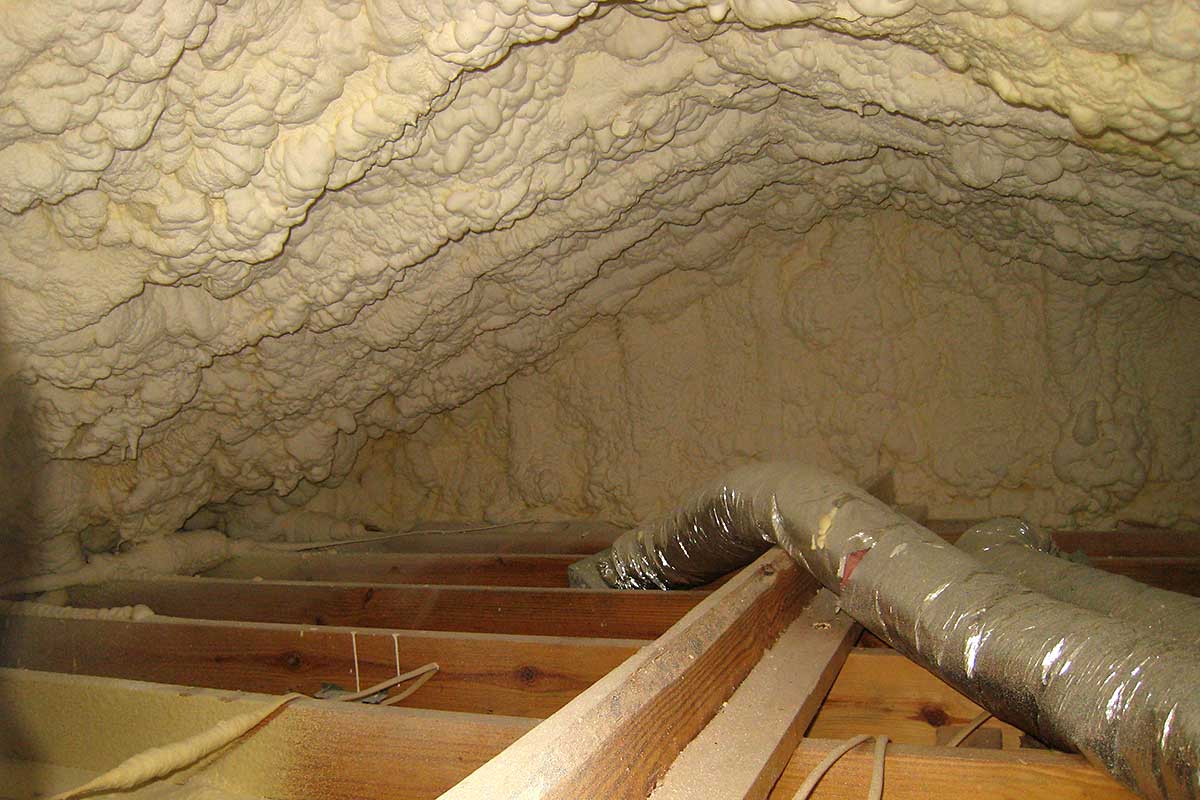For real comfort, lower AC costs, and better indoor air quality, bring the attic inside the envelope.
If your ducts live in a 120 -140°F attic, you’re paying a comfort tax every summer. Traditional vented attics try to blow that heat out with soffit and ridge vents, but in Austin’s hot-humid climate, that also invites moisture in. The smarter move for most homes (in our opinion)? A closed (unvented) attic: seal the roofline, insulate the underside of the roof deck, control humidity, and bring the attic inside the building envelope. It’s code-permitted when engineered correctly and, in our experience, delivers the most reliable comfort and efficiency gains in Central Texas. ICC Digital Codes
Quick Primer: Vented vs. Unvented (Closed)
- Vented Attic: Insulation at the attic floor; outside air enters at soffits and exits at ridge or gable vents. Benefit: simple, low first cost. Challenge in Austin: hot, moist air in the attic, with ducts and air handlers forced to work in extreme conditions.
- Unvented (Closed) Attic: Air/thermal boundary moved to the roof deck; spray foam creates a continuous air seal; the attic becomes part of the home’s conditioned volume. Benefit: ducts are now “inside,” temperatures stabilize, and humidity is managed by the HVAC/IAQ plan. Allowed by IRC R806.5 when moisture control and insulation requirements are met.
Why Closed (Unvented) Wins in Austin
Austin is an IECC Climate Zone 2A (hot-humid). Long cooling seasons plus humidity make vented attics a poor place for ducts and equipment. Unvented attics keep the system in a temperate zone, which reduces load, noise, and runtime while improving comfort.
Independent research backs this up: moving ductwork into conditioned space has cut 8 – 15% of air-conditioning costs in measured studies, before you count fewer comfort callbacks and IAQ improvements. In our market, that’s real money and real comfort. The Department of Energy’s Energy.gov
And about the classic worry, “Will my shingles overheat?” Field testing of unvented roofs with asphalt shingles shows only modest shingle temperature increases when assemblies are detailed correctly, well within roofing limits, while the efficiency and comfort benefits are significant. Building Science
Finally, ventilation in a hot-humid climate isn’t always your friend. Bringing outside air into a vented attic brings outside moisture with it. A closed attic paired with the right ventilation/dehumidification strategy keeps moisture under control instead of wrestling with it.
How We Build a Closed Attic the Right Way
- Assessment & Design
We start with a performance walkthrough: comfort complaints, duct layout/leakage, insulation condition, ceiling plane leaks, and current humidity control. Then we design the right assembly for your home and budget. - Air-Seal at the Roofline
We create a continuous air barrier at the roof deck and around penetrations. Air leakage is the enemy of durability and comfort; we stop it at the source. - Insulate the Roof Deck (Open-Cell or Closed-Cell Spray Foam)
Both foam types can meet code when designed correctly. Selection depends on roof assembly, budget, acoustics, and the moisture strategy we’re implementing. - Humidity & Fresh Air Plan
Because the attic is now inside the envelope, we ensure balanced ventilation and/or dehumidification sized for Central Texas conditions so the space stays dry and the house breathes on your terms, not the weather’s. In advanced cases, we can integrate options like vapor diffusion ports or buried ducts, but most projects simply need a clean IAQ plan. - Code Documentation (IRC R806.5)
We build and document to the unvented-attic provisions so your home meets the letter and spirit of the code.
When a Vented Attic Still Makes Sense (For Now)
Sometimes timing or budget points to a phased plan. If you keep a vented attic for the moment, we’ll still make it perform:
- Air-seal at the ceiling plane (top plates, can lights, chases) so conditioned air stays in the house.
- Baffles plus Continuous Soffit-to-Ridge Path to keep insulation from blocking intake.
- Insulation Top-Up to levels aligned with current guidance for Climate Zone 2 (often targeting R-49 in the attic as feasible). ENERGY STAR
Radiant barriers can further reduce attic heat gain and ease AC load, especially when ducts are up there. Savings vary by climate, geometry, and duct layout, which is why we treat radiant barriers as a complement to air-sealing and insulation, not a substitute. Oak Ridge National Laboratory+1
Cost, Comfort, and IAQ: What Homeowners Actually Feel
- Lower AC Runtime & Bills: With ducts inside a calm attic, more of your cooling dollar reaches rooms without reheating in a 130°F plenum. Studies quantify the savings; your thermostat shows the rest.
- Even Room Temperatures: Hot upstairs bedrooms and bonus rooms become livable at 5 p.m. – not just midnight.
- Quieter, Cleaner Air: A sealed roofline reduces dust infiltration from the attic and pairs well with modern filtration and dehumidification.
- Durability: Less condensation risk at the roof deck when the assembly is detailed correctly; fewer callbacks and comfort complaints.
FAQs About Vented vs. Unvented Attics in Austin
Is a Closed (Unvented) Attic Legal Here?
Yes. IRC R806.5 allows unvented attic assemblies when required conditions are met (air-impermeable insulation at the roof deck, proper moisture control, etc.). We design, build, and document to these provisions.
Will My Shingles Overheat?
Testing shows only small, acceptable increases in shingle temperature when unvented assemblies are detailed correctly. The efficiency and comfort gains outweigh this concern for most homes.
Open-Cell or Closed-Cell Foam?
Both can work. We specify based on roof assembly, budget, acoustics, and moisture strategy for CZ 2A.
If I Stay Vented, What Insulation Level Should I Target?
Aim for guidance aligned with Zone 2 attics (commonly R-49 where feasible) and prioritize ceiling air-sealing and baffles first.
